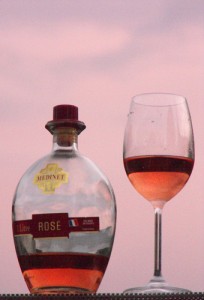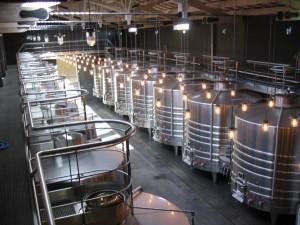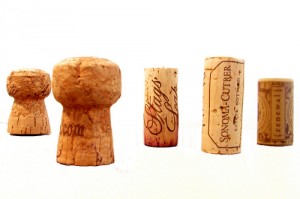There are many characteristics that combine to create a quality wine, including color, aroma, and flavor. Similar to red wine, rosé wine color is likely due to the presence of anthocyanins originating from the skins of the grape, as well as pigments created during the fermentation and aging process. In red wine making, more of these and other compounds are extracted into the wine, due to the relatively long maceration process (i.e. skin and seed contact with the juice). In rosé winemaking, however, the maceration process is often much shorter, though this does depend on the particular technique used.
There has been a great deal of research examining changes in anthocyanin concentrations over time in red wine, however, very little is known about the behaviors of these compounds over time in rosé wines. Due to some similarities in the winemaking process, it is possible that anthocyanin evolution over time in rosé wines may be similar to that of red wines.
Changes in chemical composition of wine over time can be due to many factors, though oxidation is one mechanism that can have a profound effect on this composition. Oxygen exposure can occur at many steps during the winemaking
process, including processing, bottling, and storage. Even the type of closure used in a wine bottle has been shown to influence the chemical composition of wine over time. Some specific changes that have been noted related to oxygen transfer rate in red wine (i.e. the amount of oxygen a medium allows through), include the reactions between anthocyanins and other compounds to create polymers, and the formation of sulfite bleach-resistant pigments, both of which may be indicative of an oxidative environment.
Though much is known about chemical composition evolution in red wines, very little is known about chemical composition evolution in rosé wines and nothing is known about the effects of oxygen exposure on this evolution. The goal of the study presented today, which due to space considerations I am leaving out a significant amount of detail regarding some specific results, aimed to examine the effect of oxygen transfer rate on the evolution of phenolic composition, color, and sensory characteristics of rosé wine.
Methods
Grenache grapes (2007 vintage) from the INRA Pech Rouge Experimental Unit Station in Gruissan, Southern France, were mechanically harvested at maturity (21oBrix, pH 3.5).
Grapes were separated into two lots in order to produce two different experimental rosés.
Rosé 1: 50mg/L of SO2 was added immediately after harvest. Grapes were destemmed and crushed and underwent 5 hours of maceration. This wine was maintained with CO2 pellets throughout the processing and nitrogen supplementation.
Rosé 2: Grapes were destemmed and crushed, treated with 30mg/L of SO2, and underwent 5 hours of maceration.
Both wines: After maceration, wines were racked, then treated with Rapidase CB and cooled to 2oC. After one night of treatment, wine must was transferred to
stainless steel tanks and inoculated with 30mg/L of two different yeast preparations. After alcoholic fermentation, both wines were racked, treated with sulfites, and stored at 10oC for 4 months. Wines were microfiltered on a 0.3μm membrane 1 week prior to bottling.
Wines were bottled in 375mL glass bottles. Synthetic closures from Nomacorc were used to close the bottles. Wines were separated into four batches with differing levels of oxygen transfer rates. Some wines were exposed to ambient air oxygen levels (21%), while others were kept in stainless steel tanks and exposed to 4% and 0% oxygen levels. Oxygen transfer rate and total consumed oxygen were measured for all wines.
Enological parameters measured were: free and total SO2, carbon dioxide, total acidity, malic acid, acetaldehyde levels, pH, and alcohol percentage.
Chemical compounds measured were: anthocyanins, hydroxycinnamic acids, and flavanols. Color was measured via spectrophotometric absorbance and color intensity. Total color of pigments and total polyphenol index were measured for all wines.
For sensory analysis, a panel of 18 judges (14 women and 4 men) were chosen based on their sensory analysis experience and were trained to perform descriptive analysis on wine. Wines were presented to the panelists in duplicate and in random order. For visual analysis, wine was presented in 215mL clear glasses. For taste/aroma analysis, wine was presented in black 215mL wine glasses to avoid any alteration in flavor/taste due to visual perceptions.
Results
At Bottling:
- The two rosé wines were significantly different in terms of phenolic composition, enological parameters, and sensory characteristics.
- Rosé 1: lower levels of alcohol, total and volatile acidity, malic acid and higher levels of free SO2, and CO2.
- Rosé 2: More red/pink, lower proportion of sulfite bleaching-resistant pigments, higher concentration of anthocyanins in the form of colorless bisulfite adducts. Significantly higher levels of some anthocyanins and caftaric acid; higher color intensity; more sour and less sweet.
After 10 Months of Storage:
- Both wines showed lower levels of CO2 as well as free and total SO2 and higher levels of acetaldehyde.
- Rosé 2: The loss of sulfites significantly increased with increased oxygen transfer rate. This wine had a slightly lower pH than Rosé 1. Color intensity was higher for this wine, as well as the concentration of total phenolics.
- Both wines showed lower levels of most grape phenolic compounds (expect flavanols) at 10 months after bottling compared with immediately after bottling.
- Concentrations of anthocyanins and flavanol-anthocyanin adducts were lower in wines stored with closures having higher oxygen transfer rates.
- Concentrations of phenyl derivatives of pyranoanthocyanins were higher in wines stored with closures having higher oxygen transfer rates.
- For both wines and closure types, in terms of sensory changes, fruity characters, color, and pink shades significantly increased.
- “Animal odors/flavors” decreased with higher oxygen transfer rates in all wines.
- Rosé 2 showed a trending increase in floral and peach notes, which increased over storage time.
Principle Components Analysis Results
- Lower oxygen transfer rates were associated with higher concentrations of anthocyanins, bisulfate adducts, free and total sulfites, with a more intense pink color.
- Lower oxygen transfer rate wines were associated with more animal flavor/aroma, whereas higher oxygen transfer rate wines were associated with more fruity and floral aromas/flavors.
- Rosé 2 showed higher color intensity and more pink color.
- Rosé 1 was more sour than sweet compared to Rosé 2, had higher acidity levels, and higher CO2 levels.
Conclusions
I am leaving out many of the detailed results of this study; due to the sheer volume of information versus the relatively small space allotted for a blog post (though I’m sure some of you would argue my blog posts are still too long as it is). If you’re curious about the results for any particular chemical compound, please feel free to ask.
Overall, these results showed significant differences in the rosé wines, some of which were attributed to winemaking techniques and others which were attributed to closure types. Specifically, many of the enological parameters were due to the different types of yeasts used for Rosé 1 and Rosé 2, and closures with greater levels of oxygen transfer resulted in differences in those chemicals that are formed during and after fermentation by chemical reactions within the wine. Over 10 months of storage time, the results of this study showed that many of the parameters measured immediately prior to bottling were retained over time. There did appear to be a loss in sulfites, though this was found to be proportional to oxygen transfer rate in Rosé 2 only.
In general, higher levels of free and total sulfites were associated with wines with low oxygen transfer rates. This makes sense to me, since a closure that doesn’t allow as much oxygen to flow through in theory should not allow other molecules to escape as well (or at least not ones of a particular size). Of course, there is more to this story, but that should at least give you a head start in understanding the concept.
In regards to color, higher levels of color intensity after 10 months of storage was associated with closures possessing higher oxygen transfer rates. According to the authors, this is likely partially due to the loss of sulfites and release of anthocyanins from bisulfite adducts which is similar to how color intensity behaves in red wines over time.
Overall, the results of this study showed that different winemaking techniques, specifically the use of different yeasts, produce rosé wines that differ in chemical composition as well as color and flavor/aroma. These characteristics were generally maintained over a 10 month storage period, however, some changes to anthocyanin concentrations (color intensity) related to oxygen exposure did occur.
As confirmed with red wines, the rosé winemaking process as well as the choice of bottle closure significantly impacts the finished composition of the wine, which may result in changes in overall wine quality. It was not made clear in this study which rosé the sensory panel actually preferred, so it is not clear which of the two resulted in a higher quality wine (though one can infer from the chemical composition presented). However, this study does provide important information that winemakers may apply to their own experiences in order to produce a wine with the desired chemical composition and sensory characteristics that result in a quality product.
Source: Wirth, J., Caillé, S., Souquet, J.M., Samson, A., Dieval, J.B., Vidal, S., Fulcrand, H., and Cheynier, V. 2012. Impact of post-bottling oxygen exposure on the sensory characteristics and phenolic composition of Grenache rosé wines. Food Chemistry 132: 1861-1871.




1 comment for “The Effect of Winemaking Technique and Oxygen Exposure During Storage on Rosé Wine Quality”